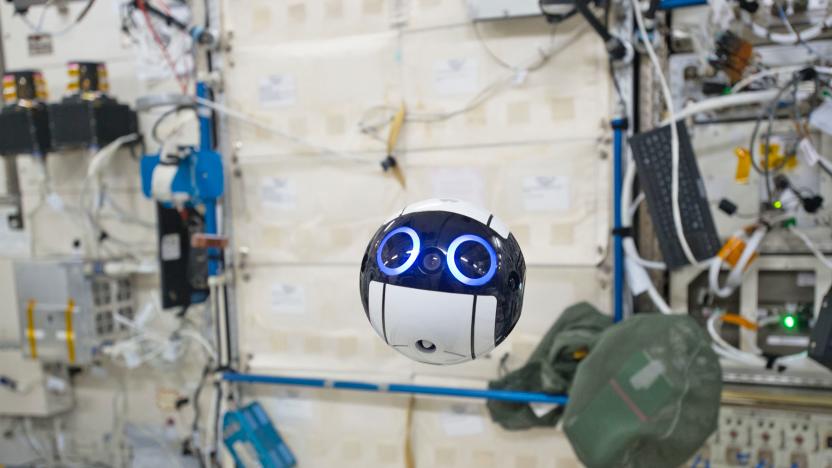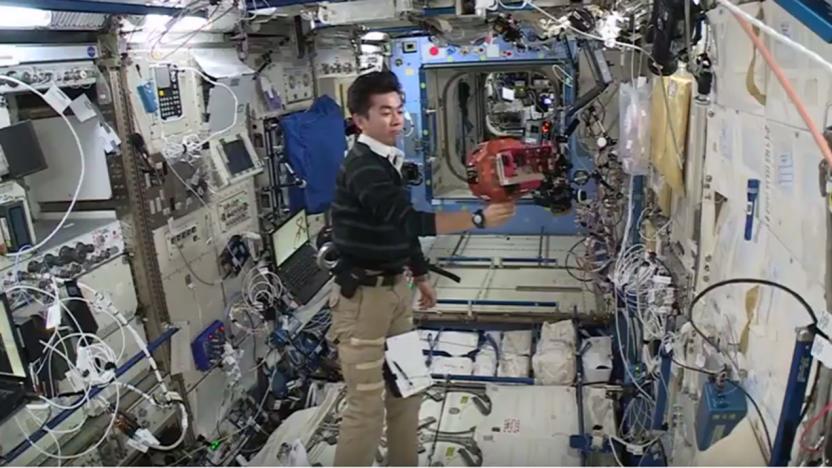TL18ROBO
Latest

The newest ISS 'crew member' will be a flying robot with AI (updated)
A curious robot is heading to the ISS aboard the next SpaceX resupply mission. It's shaped like a ball with a flattened surface where its face is drawn on a screen -- plus, it can speak, respond to spoken commands and fly. The machine called CIMON, which is short for Crew Interactive Mobile Companion, is pretty much a flying IBM-developed brain with a body and flight mechanism created by Airbus. It's the companies' joint project with the German Aerospace Center and was created to be a hands-free assistant that can make astronauts' tasks easier.

Meet the International Space Station’s adorable camera drone
Astronauts on board the International Space Station have a new robotic companion to play around with. The Japan Aerospace Exploration Agency (JAXA) has released the first images shot by the "Int-Ball," a spherical camera that floats around alongside the rest of the crew. With its monochrome paint job and blue, circular eyes, it looks a little like Wall-E's Eve — or at least her head, in some kind of prototype form. Notably, the Int-Ball can move around autonomously or be controlled by operators back on Earth. The images are transferred in near real-time allowing JAXA staff to quickly evaluate problems and offer possible solutions to ISS residents.

Space drone learns how to see with one eye in zero-G
One of the small drones aboard the ISS taught itself how to go around station with just one eye, and it was a lot harder than you might think. For starters, the SPHERE drone (that's short for Synchronized Position Hold Engage and Reorient Experimental Satellite) learned on its own by using machine learning. That method isn't typically used for space applications, because if it fails, it could result in a costly catastrophe. This is the first time a drone in space employed the technique to teach itself. Robots also still can't judge distances between objects using just one camera. Plus, the drone was operating in microgravity, floating around in a place where there's no up or down.

NASA Spacebot, what big eyes you have
Space isn't exactly the safest of places for squishy meatbags like us, what with the lack of atmosphere and all. But when satellites in orbit break, somebody's got to fix them. That's why NASA is developing a robotic remote viewing system called the VIPIR (Visual Inspection Poseable Invertebrate Robot). It leverages an articulating borescope as well as a zoom-lens camera to help Earth-bound engineers troubleshoot external issues aboard the ISS, launch vehicles and satellites. NASA is currently in the second phase of operational testing with the VIPIR. Eventually the space agency hopes to eventually pair these eyes with Dextre, Canada's dual-armed spacebot that is currently serving aboard the ISS.

Robot fixes robot on the ISS so astronauts don't have to (video)
When something goes wrong with the ISS, astronauts usually don their suits and brave the harsh conditions of space to do what needs to be done. But the space station's Canadian robotic arm (aptly called Canadarm2) is currently attempting to fix itself with minimal human input, thanks to its very special passenger -- a multi-limbed helper robot called Dextre. Canadarm2 carries the handymanrobot around to fix anything that's broken on the ISS or to catch unmanned vehicles headed for the station, such as SpaceX's Dragon capsule. This time, though, Canada's Space Agency is remotely controlling Dextre to move and replace old cameras on Canadarm2 itself.

'Kirobo, please stop talking and open the pod bay doors' (video)
Kirobo, the mini-robot / Japanese Space Agency marketer, has spoken his first words in space after being launched last month. The University of Tokyo and Toyota research project wished Earth "good morning" and mouthed other space platitudes from his perch at the International Space Station. The bot can also recognize voices and will converse with astronauts as part of his mission goals. Then, after he's lulled them into a false sense of security...

NASA's Robonaut 2 shown pushing buttons, firing lasers on the ISS (video)
Robonaut 2 is the International Space Station's friendly 300-pound killbot android assistant. It's there to assist the team with science experiments and probably capture alien life at the expense of the crew. After being fitted with more heat-sinks to enable its delicate machinery to work for longer, it was given the job of monitoring the on-board air velocity to ensure the humans didn't choke to death. Since it doesn't have legs (they're still being built on the ground), it was only able to monitor the air in the Destiny Laboratory, but the test proved so successful that NASA hopes future robots will take over the more dangerous or mundane elements of space work -- at least until they become self-aware and unionize.




